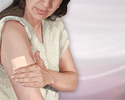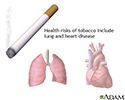Nicotine and tobacco
Withdrawal from nicotine; Smoking - nicotine addiction and withdrawal; Smokeless tobacco - nicotine addiction; Cigar smoking; Pipe smoking; Smokeless snuff; Tobacco use; Chewing tobacco; Nicotine addiction and tobacco
The nicotine in tobacco can be addictive like alcohol, cocaine, and morphine.
Causes
Tobacco is a plant grown for its leaves, which are smoked, chewed, or sniffed.
Tobacco contains a chemical called nicotine. Nicotine is an addictive substance.
Millions of people in the United States have been able to quit smoking. Although the number of cigarette smokers in the United States has dropped in recent years, the number of smokeless tobacco users has steadily increased. Smokeless tobacco products are either placed in the mouth, cheek, or lip and sucked or chewed on, or placed in the nasal passage. The nicotine in these products is absorbed at the same rate as smoking tobacco, and the potential for addiction is still very strong.
Both smoking and smokeless tobacco use carry many health risks.
Symptoms
Nicotine use can have many different effects on the body. It can:
- Decrease the appetite -- Fear of weight gain makes some people unwilling to stop smoking.
- Boost mood, give people a sense of well-being, and possibly even relieve minor depression.
- Increase activity in the intestines.
- Create more saliva and phlegm.
- Increase the heart rate by around 10 to 20 beats per minute.
- Increase blood pressure by 5 to 10 mm Hg.
- Possibly cause sweating, nausea, and diarrhea.
- Stimulate memory and alertness -- People who use tobacco often depend on it to help them accomplish certain tasks and perform well.
Symptoms of nicotine withdrawal appear within 2 to 3 hours after you last use tobacco. People who smoked the longest or smoked a greater number of cigarettes each day are more likely to have withdrawal symptoms. For those who are quitting, symptoms peak about 2 to 3 days later. Common symptoms include:
- Intense craving for nicotine
- Anxiety
- Depression
- Drowsiness or trouble sleeping
- Bad dreams and nightmares
- Feeling tense, restless, or frustrated
- Headaches
- Increased appetite and weight gain
- Problems concentrating
You may notice some or all of these symptoms when switching from regular to low-nicotine cigarettes or reducing the number of cigarettes you smoke.
Treatment
It is hard to stop smoking or using smokeless tobacco, but anyone can do it. There are many ways to quit using tobacco.
There are also resources to help you quit. Family members, friends, and co-workers may be an important source of support. Quitting tobacco is hard if you are trying to do it alone.
To be successful, you must really want to quit. Most people who have quit smoking were unsuccessful at least once in the past. Try not to view past attempts as failures. See them as learning experiences.
Most smokers find it hard to break all the habits they have created around smoking.
A smoking cessation program may improve your chance for success. These programs are offered by hospitals, health departments, community centers, work sites, and national organizations.
Nicotine replacement therapy may also be helpful. It involves the use of products that provide low doses of nicotine, but none of the toxins found in smoke. Nicotine replacement comes in the form of:
- Gum
- Inhalers
- Throat lozenges
- Nasal spray
- Skin patches
You can buy many types of nicotine replacement without a prescription.
Your health care provider can also prescribe other types of medicines to help you quit. Varenicline (Chantix) and bupropion (Zyban, Wellbutrin) are prescription medicines that affect the nicotine receptors in the brain.
The goal of these therapies is to relieve cravings for nicotine and ease your withdrawal symptoms.
Health experts warn that e-cigarettes are not a replacement therapy for cigarette smoking. It is not known exactly how much nicotine is in e-cigarette cartridges, because information on labels is often wrong.
Support Groups
Your provider can refer you to stop smoking programs. These are offered by hospitals, health departments, community centers, work sites, and national organizations.
Outlook (Prognosis)
People who are trying to quit smoking often become discouraged when they do not succeed at first. Research shows that the more times you try, the more likely you are to succeed. If you start smoking again after you have tried to quit, do not give up. Look at what worked or did not work, think of new ways to quit smoking, and try again.
Possible Complications
There are many more reasons to quit using tobacco. Knowing the serious health risks from tobacco may help motivate you to quit. Tobacco and related chemicals can increase your risk for serious health problems such as cancer, lung disease, and heart attack.
When to Contact a Medical Professional
See your provider if you wish to stop smoking, or have already done so and are having withdrawal symptoms. Your provider can help recommend treatments.
References
Atkinson DL, Minnix J, Cinciripini PM, Karam-Hage M. Nicotine. In: Johnson BA, ed. Addiction Medicine: Science and Practice. 2nd ed. Philadelphia, PA: Elsevier; 2020:chap 23.
Brunetta PG, Kroon L. Smoking cessation. In: Broaddus VC, Ernst JD, King TE, et al, eds. Murray and Nadel's Textbook of Respiratory Medicine. 7th ed. Philadelphia, PA: Elsevier; 2022:chap 66.
George TP. Nicotine and tobacco. In: Goldman L, Cooney KA, eds. Goldman-Cecil Medicine. 27th ed. Philadelphia, PA: Elsevier; 2024:chap 363.
Gotts JE, Benowitz NL. Smoking hazards: Cigarettes, vaping, marijuana. In: Broaddus VC, Ernst JD, King TE, et al, eds. Murray and Nadel's Textbook of Respiratory Medicine. 7th ed. Philadelphia, PA: Elsevier; 2022:chap 65.
US Preventive Services Task Force; Krist AH, Davidson KW, Mangione CM, et al. Interventions for tobacco smoking cessation in adults, including pregnant persons: US Preventive Services Task Force recommendation statement. JAMA. 2021;325(3):265-279. PMID: 33464343 pubmed.ncbi.nlm.nih.gov/33464343/.
Review Date: 7/25/2022
Reviewed By: Linda J. Vorvick, MD, Clinical Professor, Department of Family Medicine, UW Medicine, School of Medicine, University of Washington, Seattle, WA. Internal review and update on 07/23/2023 by David C. Dugdale, MD, Medical Director, Brenda Conaway, Editorial Director, and the A.D.A.M. Editorial team.





